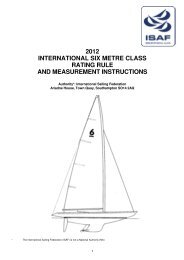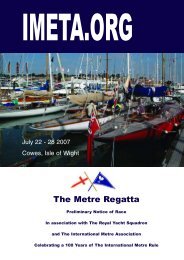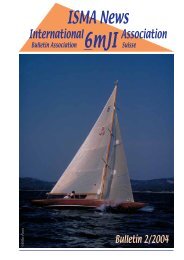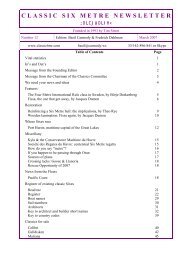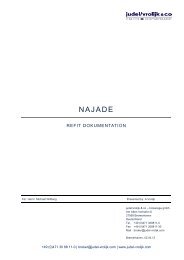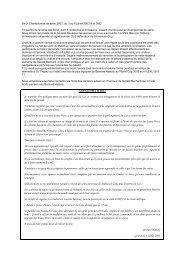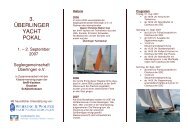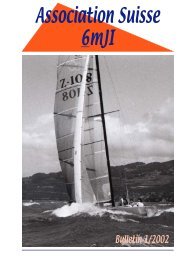ISMA News - Association Suisse 6mJI
ISMA News - Association Suisse 6mJI
ISMA News - Association Suisse 6mJI
You also want an ePaper? Increase the reach of your titles
YUMPU automatically turns print PDFs into web optimized ePapers that Google loves.
<strong>ISMA</strong> <strong>News</strong> International <strong>6mJI</strong> <strong>Association</strong> Bulletin 1/2004<br />
The metric rule is at the origin of beautiful yachts such as the J boat (23m), 19m, 15m, 12m, 10m, 9m, 8m, 7m, 6m and 5m,<br />
but we should admit that it has not been the success planned by the conceivers at the beginning of this century. The<br />
multiplicity of the national series slowly dropped down, and boats as Sonderklasse or 6.5m almost disappear. In term of<br />
naval architecture the metric rule was more a step backward than forward, the meter yachts were heavy and therefore<br />
expensive and relatively underpowered (sail area was small compared to other series). The success of the rule is due to the<br />
selection of the 8m and 6m for the Olympics, than for the One Ton Cup and of course of the J and later the 12m for the<br />
America’s Cup.<br />
The evolution of the hull shape has been slow, the formula being very restrictive, and it essentially the fact of massive<br />
investment for the America’s Cup which allowed new ideas to emerge. Olin Stephens first with Intrepid brought the<br />
principle of the trimmer and the rudder splitted from the keel . In 1983 Ben Lexcen was successful with the wingged keel<br />
of Australia and in 1987 USA from Tom Blackhaller innovates with a “canard” rudder ahead of the keel.<br />
The metric rule is still well alive today, new 8m, 6m are build around the world, even if it has been abandoned for the<br />
America’s Cup.<br />
It is worth to mention that the new America Cup Class , is using a formula pretty close to the metric formula , but with<br />
different limitations and specially no more““d” factor (girth difference at mid-ship), allowing now to create much faster<br />
canoe body hull with a bulb keel .<br />
Factors from the rule influencing the performances of the sail boat.<br />
The factors used in the metric formula have each a specific role in the performance of the yacht. The measured length L<br />
figures a dynamic waterline length, or more accurately the waterline length when the yacht is heeling. L is measured 1.5%<br />
above the real waterline length (120 mm for an 8m yacht) in order to avoid overhang with a minimal slope which would<br />
immediately increase drastically the flotation when the yacht is sailing.<br />
In addition to the L measure girth differences at the bow and at the stern of the hull are added to take into account the<br />
volume of the extremities. This factor is critical to evaluate the dynamic waterline length which is determinant for the<br />
theoretical maximum boat speed<br />
The square root of the sail area, real engine of the yacht, is part of the formula. One may question why the suare root, in fact<br />
this compensate the fact that the displacement increase proportionally to the cube of the waterline length.<br />
The average Freeboard F is included as a deduction (smaller it is less the yacht can carry sail area), its impact on the<br />
yacht performance is to increase the height of the centre of gravity and therefore increase the heel what is unfavourable to<br />
the yacht performance.<br />
The last visible item in the formula is the d factor and is the most complex one to understand. At the origin its goal was to<br />
control the displacement avoiding the creation of canoe body hull with low immersed volume and therefore corresponding<br />
to light vessels.<br />
In its last revision(!(£$) the rule has embedded as a constraint a minimum displacement function of the cube of the<br />
waterline length LWL. From this perspective the factor d today only impede the architects to create flat (light and fast!)<br />
hulls as can be seen in the 5.5m and America’s Cup Class series.<br />
The numerical factor’2.37 at the denominator of the formula has only the merit to obtain results such as 6m, 8m, 12m,<br />
etc...<br />
Guy-Roland Perrin<br />
ISAF measurer<br />
59



